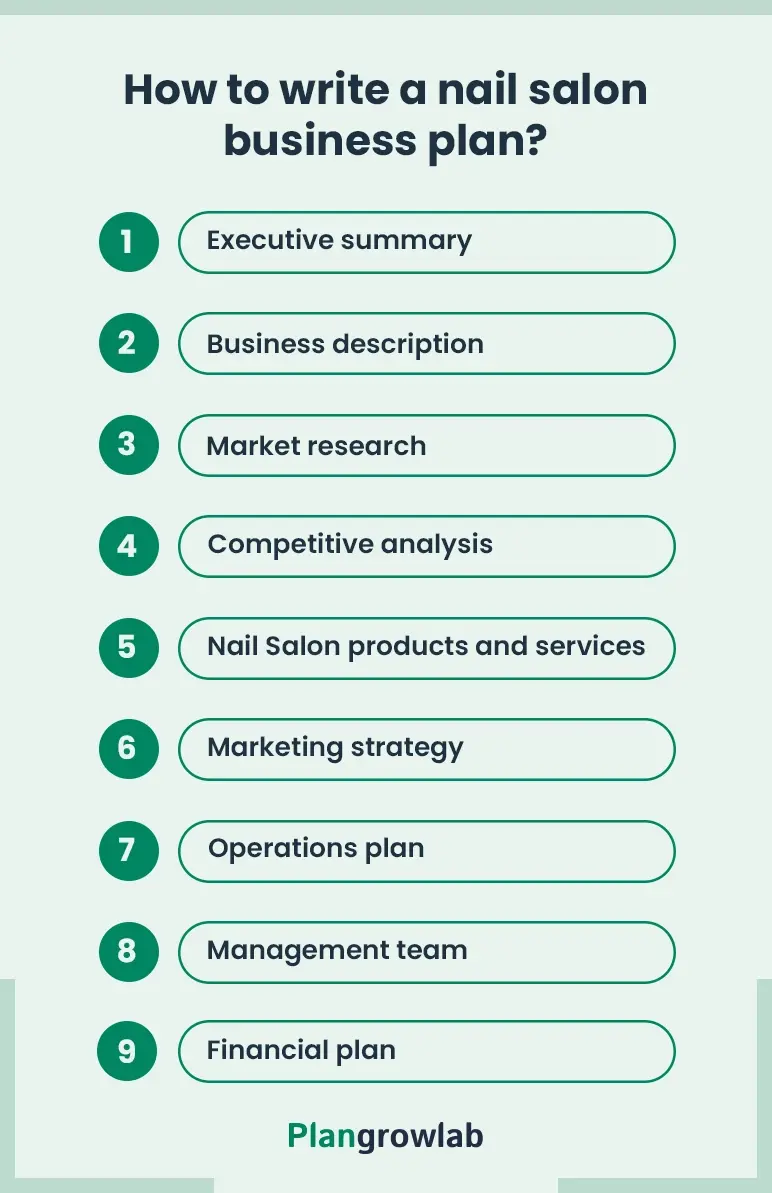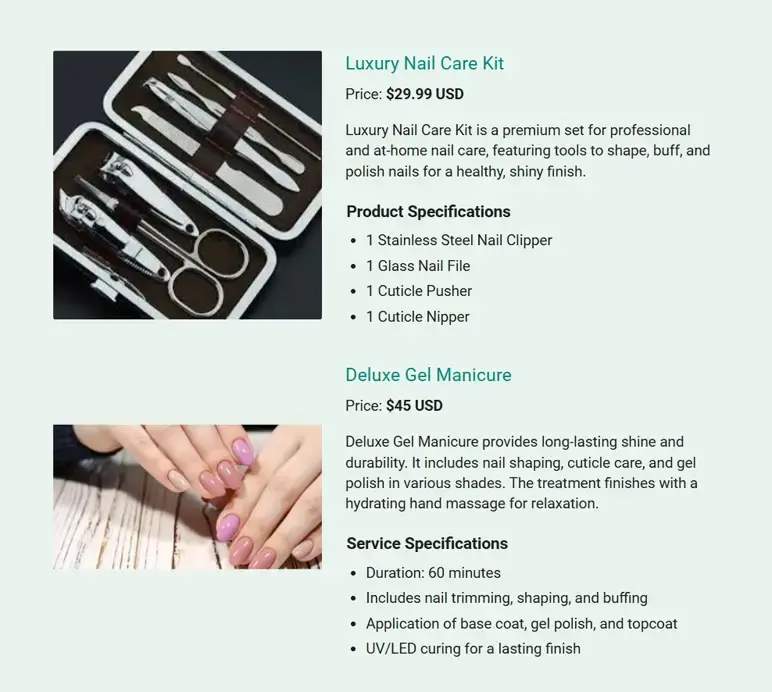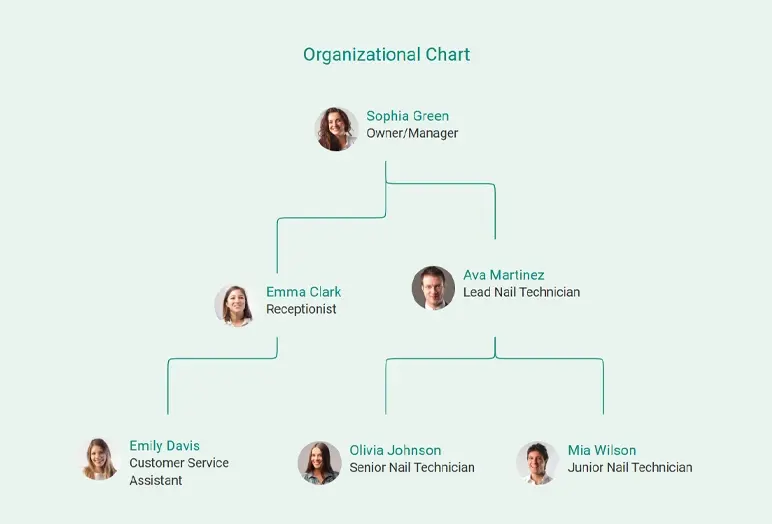Starting a business without a clear plan can be hard. That’s something I learned when I spoke with Tien Truong, the owner of "Amazing Nails" in San Rafael, California.
She opened up about how she turned her love for nail art designs into a full-time business, her challenges, and what it took to get where she is today.
This guide is based on that conversation. It’s packed with practical tips and insights to help you create a nail salon business plan.
Why do you need a business plan for your nail salon?
Starting a nail salon without a plan is like doing nail art without a design—you might end up with something, but it won’t be what you expected.
That’s why a solid business plan is important. It sets clear goals, outlines your nail services, identifies your target customers, and maps out marketing strategies.
It also helps you estimate costs, set prices, and ensure profitability. Plus, it prepares you for equipment needs, staffing, and promotions.
If you’re looking for funding, a business plan shows lenders and investors that you’ve done your research and have a solid strategy to make your nail salon a success.
How to write a nail salon business plan?
In this guide, you’ll see what a nail salon business plan should include and how to put it all together step-by-step.

1. Executive summary
An executive summary gives a brief overview of your entire business plan.
Although it’s the first section of your business plan, it’s often best to write it last. By completing the other sections first, you’ll have a clearer understanding of how to summarize your plan effectively.
You can start with basic details like —the name of your nail salon, the location, and what makes it stand out.
Then, briefly touch on your service offerings, target customers, and goals.
The main idea here is to grab attention. Whether it’s an investor, a lender, or even a partner reading it, this is your chance to get them interested right away.
"When I started writing my executive summary for my nail salon, I made the error of putting too much information. This is because I kept adding and adding. After all, I thought that everything was important.
Before I knew it, it was too long. That's when I realized this section just needed a quick snapshot, not the full story. It was hard deciding what to keep and what to cut, but I finally narrowed it down.
I began with the name of the nail salon, its location, and what makes it unique. Then I included a little about nail services, target customers, and goals."—Tien Truong
2. Business description
This is where you introduce your nail salon business and share what makes it unique. It’s your chance to explain who you are, what you offer, and what sets your nail salon apart from others.
Get started with the basics:
- Your nail salon’s name and location.
- The business structure—whether it’s a sole proprietorship, partnership, or LLC.
Highlight your nail salon’s focus:
- Are you offering affordable services, luxury treatments, or eco-friendly options?
- What’s your mission and vision for the nail salon?
- What type of experience do you want to create for your clients?
Long-term thinking:
Describe where you see your nail salon 5 or 10 years from now and how you will grow there. You can discuss increasing services, opening up more locations, or even having a product line.
"While working on the business description for my nail salon, I realized that I had too much content since I had already gathered plenty of details while planning the executive summary.
The tricky part was what to keep and how to make it flow properly.
First, I included the basic information: the name of my nail salon, its location, and the fact that it is an LLC. Then, I emphasized what makes my nail salon different: eco-friendly products, reasonable prices, and luxury services such as spa pedicures and custom design.”—Tien Truong
3. Market research
Market research is all about understanding your local nail salon market, customers, and the latest trends in your nail salon industry.
Start by identifying your target customers—who they are, what they need, and what nail salon services they’re looking for.
Focus on gaps in the target market, like green products or trendy design, to position your salon as the better choice.
Look at beauty industry trends. Are customers leaning more toward organic products or custom designs?
Finally, review pricing. Determine whether your nail salon will be cheap, expensive, or something in between based on your target audience and services.
"When I was planning my salon, I spent a lot of time figuring out what people wanted. I noticed that people were much interested in eco-friendly products and custom designs so I focused a lot on that.
It took many trials and errors to know the target market but listening to customers helped me a lot in understanding them."—Tien Truong
4. Competitive analysis
The competitive analysis provides insight into other nail salons in your area and demonstrates how your salon will stand out.
List how many nail salons are around and the services they provide along with their pricing strategy. Look at their strengths and weaknesses, like great customer reviews or limited service options.
Identify the potential gaps you might fill to meet target market needs. This will help you explain what makes your nail salon different. It could be eco-friendly products, affordable pricing, unique nail art, or better customer service.
"I found that there were too many nail salons everywhere. At first, that was really overwhelming, so I knew I had to understand what was making some successful and where they were wrong.
I visited several nail salons, checked their pricing, and even booked a few appointments to experience their services firsthand. I also read online reviews to see what customers liked and complained about.
The key point that I noted from my research was that all nail salons provided bare essentials but lacked eco-friendly products, custom nail art, and spa-style treatments. And this is when I settled on these niches in which to specialize my business."—Tien Truong
5. Nail Salon products and services
This section is the center of your whole business plan and outlines exactly what you’ll offer and how it’ll attract customers.
List all of your services: manicures, pedicures, gel nails, nail art, nail polish, and spa treatments. Do not forget to list any special services such as bridal packages, kids' nail care, or mobile services for parties and events.
Additionally, share the products like nail care kits, polishes, and other related accessories.

Furthermore, share any ideas for launching new services or products in the future. You can also consider adding customer testimonials or feedback to show the value of your services.
“When I first wrote this section, I realized that I was listing too many services without explaining how they'd stand out.
So I stepped back and focused on my top products: manicures, pedicures, and nail art, and then added all the additional information about green polish and spa treatments.
I also added aromatherapy hand massages as add-ons and retail products like nail care kits.”—Tien Truong
6. Marketing strategy
Marketing is the key to pulling customers through the door so, this section should explain how you’ll market your nail salon.
Start with online strategies, like using social media platforms to display your work. For example, you could establish an Instagram page which is one of the powerful tools for beauty services when sharing eye-catching photos and videos of designs.
If you target a younger group, you might even team with influencers to get the message out.
Finally, do not miss discussing your loyalty programs, discounts for referrals, and offers for first-time clients.
"I started with affordable marketing by posting before and after pictures on Instagram and placing local Facebook advertisements.
To increase repeat business, I added loyalty cards, referral discounts, and combined efforts with local businesses for increased visibility, such as bridal shops.
Word-of-mouth marketing was the most potent, where happy clients invited friends to visit, and this strategy had to be based on customer satisfaction to create a constant stream of people returning."—Tien Truong
7. Operations plan
Your business operations plan clearly explains the day-to-day activities of your salon and tells how things should be running.
While planning this section, add details such as:
- Business hours & staffing: List operating hours and staffing plans—full-time, part-time, or contractors. Specify roles and responsibilities.
- Equipment & inventory: Detail chairs, tools, and polish collections. Explain how inventory will be managed to avoid shortages.
- Appointments & payments: Use online booking tools for scheduling and point-of-sale systems for payments and revenue tracking.
You can also discuss hygiene and safety standards, which are critical in the nail salon industry.
“Organizing the daily operations in my nail salon was quite a big challenge. This included business hours that matched the customer's schedules as well as the decision on whether to hire full-time staff or part-timers.
Even inventory management proved to be another headache; I did not want to experience running out of supplies at busy hours.
Hence, I put an online booking and payment system so that appointments and sales are tracked. I created a checklist to monitor the inventory regularly.”—Tien Truong
8. Management team
As a nail salon owner, you could be managing everything yourself or leading a team of managers and staff.
Regardless of the setup, running a successful nail salon requires a skilled and experienced leadership team.
Introduce yourself and any co-owners, managers, lead nail technicians, and support staff. Highlight their roles, responsibilities, and relevant industry experience to show investors your team is equipped to handle daily operations and drive growth.
You can even add an organizational chart as given below to outline the hierarchy and roles within your nail salon.

If you have mentors, consultants, or advisors offering financial or operational guidance, be sure to mention them as part of your support network.
In short, a management team section highlights the key people responsible for running your nail salon. It shows investors that your business is backed by the skills and experience needed to succeed.
"When I started my salon, I tried doing everything by myself, whether it’s scheduling appointments, managing all the inventory, or even cleaning.
At one point I was really exhausted. I realized I needed help. So, I brought in a receptionist and a lead nail tech, and it made it much easier for me to handle everything.
If I had to give one tip, I would say don’t wait too long to get help. A good team makes running the salon so much easier."—Tien Truong
9. Financial plan
The financial plan is a key part of your business plan, showing how your nail salon will generate revenue and stay profitable. It covers:
- Startup costs: Rent, renovations, equipment, licenses, marketing, and initial supplies.
- Operating costs: The ongoing costs such as salaries, utilities, and inventory.
- Income statement: Projects revenue, expenses, and profits over time.
- Balance sheet: Summarizes assets, liabilities, and equity.
- Profit and loss statement: Tracks income and expenses to measure profitability.
- Cash flow statement: Monitors cash inflows and outflows to ensure expenses are covered.
If you’re seeking a loan or investors, this section must cover funding needs, usage plans, and repayment strategies.
"The most challenging yet rewarding part was making the financial plan for my nail salon. It included the estimate of startup costs, monthly expenses and projected revenue while being practical about the numbers.
Budgeting for equipment, inventory, and marketing took careful planning, and I built in a cushion for unexpected costs."—Tien Truong
Download our nail salon business plan template
Ready to create your nail salon business plan but still need some help to get started? No problem—we have got you covered! Download our free nail salon business plan template PDF to simplify the process.
This template is prepared with practical insights and examples so that you can outline step by step a comprehensive business plan. Just download, and customise according to your business objectives, and you are all set to take off!
Conclusion
After reading this guide, you should feel more confident about creating a detailed yet effective nail salon business plan. With the right plan in place, you’ll be well-prepared to attract clients, secure funding, and build a thriving nail salon.
However, if you need professional guidance in tailoring your plan or making it investment-ready, our business plan consulting service is here to help.
We also provide detailed business plan writing, reviewing, and financial forecasting to get you off on the right track.
Don't wait; take that first step toward making your dream nail salon a reality!
Frequently Asked Questions
What should a nail salon business plan include?
A nail salon business plan should include the following key elements:
1) Executive summary
2) Business description
3) Market research
4) Products and nail services
5) Marketing tactics
6) Operations plan
7) Management team
8) Financial plan
How much does it cost to write a nail salon business plan?
The cost of creating a nail salon business plan can vary widely, ranging from as little as $7 (or even free) to as much as $25,000. It depends on the level of detail required and how the plan is prepared.
Do I need a business plan for a small nail salon?
Yes, even for a small nail salon, a solid business plan is important. It helps set clear goals, manage finances, attract customers, and prepare for growth.
How do I attract investors to my nail salon business plan?
To attract investors, highlight what makes your nail salon unique, include solid market research, provide realistic financial projections, and show clear growth potential. Demonstrating your team’s expertise and experience can also build investor confidence.
What are the sources of funding for your nail salon business?
Common funding sources include:
1) Personal savings
2) Small business loans
3) Private investors
4) Government grants
5) Crowdfunding platforms like GoFundMe
6) Financial support from friends and family

